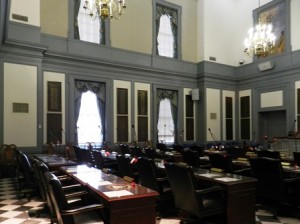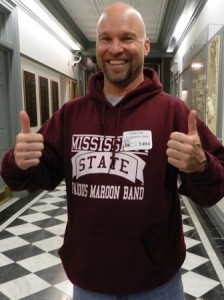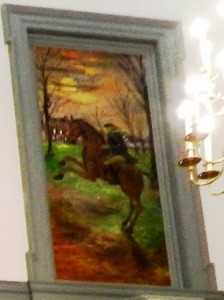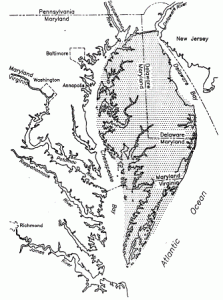‘Dover’ Category
» posted on Friday, November 22nd, 2013 by Linda Lou Burton
Getting To Goal
 Linda Burton posting from Dover, Delaware – Of course I was bragging. “This is my 49th capitol,” I said to Nathaniel and Michael, as we began our tour of Leg Hall. “Leg Hall” is the affectionate nickname for the Delaware state capitol, because it’s where the legislature has met since 1933. It’s a stately Georgian brick structure, in keeping with the history of the town; located in First State Heritage Park along with the Old State House and the Golden
Linda Burton posting from Dover, Delaware – Of course I was bragging. “This is my 49th capitol,” I said to Nathaniel and Michael, as we began our tour of Leg Hall. “Leg Hall” is the affectionate nickname for the Delaware state capitol, because it’s where the legislature has met since 1933. It’s a stately Georgian brick structure, in keeping with the history of the town; located in First State Heritage Park along with the Old State House and the Golden  Fleece Tavern, all part of a complex of state buildings and historic moments. I was reveling in my own “historic moment” as I continued my boast; “49th out of 50! Only one to go and that’s Annapolis. I’m getting close!” Both men nodded in approval, affirming they were impressed with my achievement. “Nice!” said Michael, who was visiting from Texas. “I’ve got twelve left to see myself. But, I have run a marathon in all 50 states.” Well now, that was a topper. “Picture time,” I said, grinning. “This is a thumbs-up photo op. I’ve never met anyone who has
Fleece Tavern, all part of a complex of state buildings and historic moments. I was reveling in my own “historic moment” as I continued my boast; “49th out of 50! Only one to go and that’s Annapolis. I’m getting close!” Both men nodded in approval, affirming they were impressed with my achievement. “Nice!” said Michael, who was visiting from Texas. “I’ve got twelve left to see myself. But, I have run a marathon in all 50 states.” Well now, that was a topper. “Picture time,” I said, grinning. “This is a thumbs-up photo op. I’ve never met anyone who has  run 50 marathons, much less in every state!” Michael posed for me, thumbs appropriately up. It’s interesting what people do, and how much effort they’ll put forth to achieve a goal. Tour guide Nathaniel led us into the Senate Chambers then, slipping into storytelling mode as he pointed to the murals above our heads, and told the tales of Delaware. They were people stories, of course; it’s people who had the vision, and the goals; it’s people who did what it took. Nathaniel pointed to the mural of a man on a horse; the sky had an eerie darkening cast; the trees were bare. Hurry! The horse reared up, the man’s scarf flew behind. “That is Caesar Rodney,” he began. » read more
run 50 marathons, much less in every state!” Michael posed for me, thumbs appropriately up. It’s interesting what people do, and how much effort they’ll put forth to achieve a goal. Tour guide Nathaniel led us into the Senate Chambers then, slipping into storytelling mode as he pointed to the murals above our heads, and told the tales of Delaware. They were people stories, of course; it’s people who had the vision, and the goals; it’s people who did what it took. Nathaniel pointed to the mural of a man on a horse; the sky had an eerie darkening cast; the trees were bare. Hurry! The horse reared up, the man’s scarf flew behind. “That is Caesar Rodney,” he began. » read more
» posted on Wednesday, November 20th, 2013 by Linda Lou Burton
Marvelous Delmarva
 Linda Burton posting from Dover, Delaware – “Sweet or unsweet?” My head jerked back in surprise at the question; at first I was flustered; then pleased. “You seriously have sweet tea here?” I asked my server. “Well yes, Hon, we do,” she replied, in an accent that curved sweetly upwards in syllables that were music to my ears. “Then I must be back in the south,” I grinned. “Nobody has asked me that question since January.” It was true; it was January when the Journey left Virginia headed west; since then I’d traveled the Midwestern states, the Great Lakes states, and the New England states. But today, after I crossed the Delaware Memorial Bridge from New Jersey, I entered Delmarva, where the language is Southern American English. She called me Hon! Not “Miss” or “Dear;” I was Hon again, here in this homey restaurant, where I could get iced tea that
Linda Burton posting from Dover, Delaware – “Sweet or unsweet?” My head jerked back in surprise at the question; at first I was flustered; then pleased. “You seriously have sweet tea here?” I asked my server. “Well yes, Hon, we do,” she replied, in an accent that curved sweetly upwards in syllables that were music to my ears. “Then I must be back in the south,” I grinned. “Nobody has asked me that question since January.” It was true; it was January when the Journey left Virginia headed west; since then I’d traveled the Midwestern states, the Great Lakes states, and the New England states. But today, after I crossed the Delaware Memorial Bridge from New Jersey, I entered Delmarva, where the language is Southern American English. She called me Hon! Not “Miss” or “Dear;” I was Hon again, here in this homey restaurant, where I could get iced tea that  someone had already gone to the trouble to sweeten for me. What a marvelous place! I came for Dover, of course, the 49th Capital City of the Journey; capital of the First State, Delaware. And, besides the unique distinction and bragging rights of being capital of the first state, it’s the only capital city that is on a peninsula. And that peninsula houses parts of three states – Delaware, Maryland, and Virginia. DelMarVa, get it? I’ll get into the specifics of land boundaries in later posts, but for now look at the map to understand the lay of the land. Technically, the “peninsula” is an island, thanks to the manmade 14-mile C&D Canal that connects Chesapeake Bay with the Delaware River. The Canal is considered the beginning of the Delmarva Peninsula, a mostly rural land of farms and fishing, where restaurants have collards on the menu, and the tea is sweet. » read more
someone had already gone to the trouble to sweeten for me. What a marvelous place! I came for Dover, of course, the 49th Capital City of the Journey; capital of the First State, Delaware. And, besides the unique distinction and bragging rights of being capital of the first state, it’s the only capital city that is on a peninsula. And that peninsula houses parts of three states – Delaware, Maryland, and Virginia. DelMarVa, get it? I’ll get into the specifics of land boundaries in later posts, but for now look at the map to understand the lay of the land. Technically, the “peninsula” is an island, thanks to the manmade 14-mile C&D Canal that connects Chesapeake Bay with the Delaware River. The Canal is considered the beginning of the Delmarva Peninsula, a mostly rural land of farms and fishing, where restaurants have collards on the menu, and the tea is sweet. » read more
